by NEIL SINYARD
According to Hitchcock’s associate producer, Herbert Coleman, ‘it was the most beautiful shot of a woman I have ever seen in my life.’ It is one of the most entrancing entrances of any screen character- a moment when, in a reversal of convention, a sleeping hero is awakened by a kiss from a Fairy Princess.
In Rear Window (1954), a professional photographer, L.B. Jefferies (James Stewart), in a wheelchair with a broken leg after an accident at one of his assignments, is asleep in his apartment. Suddenly a sinister shadow falls across his face, which puts us slightly on our guard. Hitchcock cuts to a shot of a stunningly beautiful blonde coming into seductive close-up.
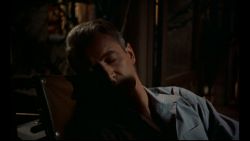
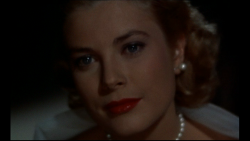
He then cuts to a close profile shot almost in slow-motion to accentuate the dreaminess of the atmosphere as hero and heroine kiss. ‘Who are you?’ asks Jefferies, jokingly. Taking up the playful tone, the heroine introduces herself- ‘Lisa Carol Fremont’-, on every name switching on a lamp as if to emphasise the warmth and light she has brought into the room.
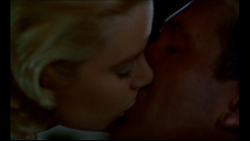
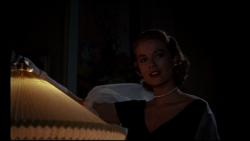
Delighted with her contribution to Dial M for Murder (1953), Hitchcock was keen to work with Grace Kelly again, a feeling that was mutual: she turned down the offer of a role in On the Waterfront (1954)- which was to win Eva Marie-Saint an Oscar- to make Rear Window instead. This time Hitchcock was keen to create a part that was closer to her actual personality. ‘She’s stiff on film,’ he told the screenwriter John Michael Hayes, ‘and we have to open her out somehow.’ Hayes spent some time with her and wrote a part which brought out the gaiety and wit of her natural temperament. Hayes’ wife had been a professional model and that helped to create a background for the character that was authentic but also, to Jefferies, provocative.
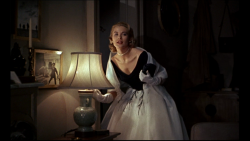 Grace Kelly’s performance has not only sparkle but shade, and the antagonism between Lisa and Jefferies (intimated by that initial shadow of his face when she first appears) in the film has several intriguing dimensions. Kelly looks gorgeous in the costumes Edith Head has designed for her (under Hitchcock’s watchful eye), but the character is far more than just a clothes-horse for glamorous garments. She is a successful and intelligent career-woman, and the hero’s mocking remarks about her life-style (‘You should list that dress on the Stock Exchange,’ he says about the $1100 dollar dress she is wearing when she greets him), reveal a touch of envy and masculine insecurity on his part. Lisa wishes to marry him but is being kept at arm’s length, ostensibly because he does not think she could share the rough and tumble of his life as a magazine photographer, subconsciously because he seems to fear marriage itself. What he watches from his window- vignettes of loneliness, desire and disappointment – only serves to reflect and perhaps deepen that fear, particularly when he begins to suspect that one of his neighbours, Thorwald (Raymond Burr) has murdered his wife.
Grace Kelly’s performance has not only sparkle but shade, and the antagonism between Lisa and Jefferies (intimated by that initial shadow of his face when she first appears) in the film has several intriguing dimensions. Kelly looks gorgeous in the costumes Edith Head has designed for her (under Hitchcock’s watchful eye), but the character is far more than just a clothes-horse for glamorous garments. She is a successful and intelligent career-woman, and the hero’s mocking remarks about her life-style (‘You should list that dress on the Stock Exchange,’ he says about the $1100 dollar dress she is wearing when she greets him), reveal a touch of envy and masculine insecurity on his part. Lisa wishes to marry him but is being kept at arm’s length, ostensibly because he does not think she could share the rough and tumble of his life as a magazine photographer, subconsciously because he seems to fear marriage itself. What he watches from his window- vignettes of loneliness, desire and disappointment – only serves to reflect and perhaps deepen that fear, particularly when he begins to suspect that one of his neighbours, Thorwald (Raymond Burr) has murdered his wife.
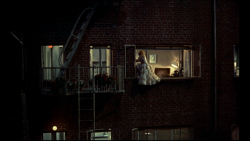
Although the action of the film is seen almost exclusively from Jefferies’ point of view, Rear Window subverts the usual Hollywood active male/ passive female narrative stereotypes. Whereas Jefferies is immobile and mostly helpless throughout the film, Lisa is one of Hitchcock’s most active and resourceful heroines. When she begins to share Jefferies’ suspicions about Thorwald, she has no compunction about crossing the courtyard and climbing into Thorwald’s room through the window, thereby demonstrating that, contrary to Jefferies’ assertion, it is possible both to dress immaculately and be effectively adventurous. And, as in The Man Who Knew Too Much, feminine intuition provides the solution to the mystery. Lisa has always contended that no woman would go on a trip without her wedding ring and when she finds Mrs Thorwald’s ring amongst her husband’s belongings, it clinches his guilt.
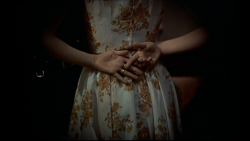
The visual revelation of that moment is brilliant. Whilst searching his room, Lisa has been attacked by Thorwald but rescued in time by the arrival of the police. Whilst they are being questioned, Lisa signals her discovery of the ring to Jefferies by wearing it on her finger and pointing to it behind her back (Thorwald will notice the gesture and later come across to confront Jefferies). As Francois Truffaut has noted, the moment serves a dual function of implicating Thorwald whilst also reinforcing Lisa’s desire for marriage: she finally has a wedding ring on her finger. At the back of our mind, though, is a disquieting thought: it is a murdered woman’s wedding ring – and, moreover, it fits.
The ending is one of Hitchcock’s most adroit, and particularly interesting in relation to Lisa and the other female characters. During the film Lisa has particularly identified with two other women across the square whom Jefferies has spied on- Miss Torso (Georgine Darcy), with her constant stream of admirers (’She’s doing a woman’s hardest job…juggling wolves,’ says Lisa, as if she knows what she is talking about); and Miss Lonelyhearts (Judith Evelyn), who acts out imaginary dates but who is then taken to the point of near-suicide when an actual date tries to assault her. These two side-stories are happily resolved: Miss Torso’s amusingly diminutive Army husband returns home; and Miss Lonelyhearts has struck up a friendship with the frustrated songwriter whose song has now been recorded and whose music has meant so much to her (and to Lisa).
The temperature has dropped; normality seems to have been restored, though the newly-weds are now bickering, as if potential Thorwalds in the making; as at the beginning of the film, Jefferies is asleep with his back to the window but, after his encounter with Thorwald, now has two broken legs, making him doubly impotent. Hitchcock now pans to Lisa, in casual slacks and blouse, reading ‘Beyond the High Himalayas’. Has she capitulated, then, to Jefferies’ requirements of a female partner? Not a bit of it. Noting he is still asleep, she puts down the book and picks up her preferred reading matter, the fashion magazine ‘Bazaar’, implicitly affirming her right to live according to her own lights and values. The last word we hear on the soundtrack is from the songwriter’s composition and it is the single word ‘Lisa’- allowing the heroine, as it were, the last word.
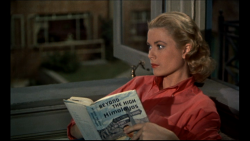
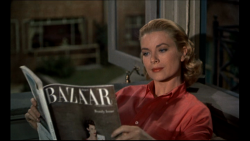
It is a scintillating characterisation and Grace Kelly plays it with a combined elegance and vitality, immaculate manner and yet sexual self-confidence that utterly enchanted Hitchcock. No wonder Rear Window remained one of his favourite films. He said it was because it was an example of ‘pure cinema’; I suspect it was also because he had found in it his perfect blonde.
